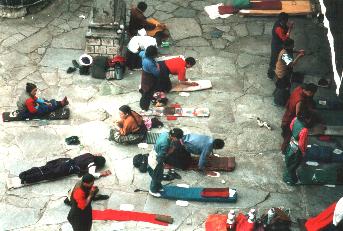| TIBET, MAY-JUNE 2001 - What makes Tibet so special ? Its people. This story tells the tale of the people of Tibet I’ve encountered on my travels through this amazing part of the world, and is meant as a tribute to their faith and courage. I try to evoke the scenes I’ve seen, but you have to see it yourself to believe it.
|
Lhasa
Let’s start in the capital, Lhasa in the barkhor area, near the Jokhang temple. Take a moment to relax and sit down on the square in front of the Jokhang, and observe the people. The most obvious are the owners of the souvenirs stalls , which try to attract your attention. Filter these ones out, and what you see is the real heart of Tibet : the pilgrims, monks, nuns, children, women going to the market place,… See the pilgrims prostrating in front of the Jokhang – some have been traveling for months from their home, or see them chanting and rotating their prayer wheels.

Now do some ‘koras’ on the Barkhor. Again avoid the souvenirs sellers, but go into the side alleys, and discover the horn-and-cymbals-playing-monks and the chanting nuns; let the prayer wheels rotate that are placed on several spots along the way, discover a crowded courtyard full of ordinary people drinking yak butter tea… Do the same walk many times; everytime something else will be around the corner. Then enter the darkness of the Jokhang (where only tourists buy tickets), smell the yak butter lamps and queue in line with the hundreds of Tibetans to see the Jowo. Go into the different chapels and look and listen… This is all too much for your senses; it’s not a museum you visit, you’re part of the daily life of Tibet now, this is living culture you experience. Then when it becomes all too much, go to the roof and see the beautifull sights, and bathe in the light, be surrounded by goldplated roofs. If you’re lucky, discuss with some of the monks. It will be hard to leave this place because you just can’t figure out what is realy happening and want to understand, experience it all again…
Villages and nomads
 |
 |
But there is more than religion alone. When you go into the ‘true wilderness’ of Tibet, you will encounter the people in the little villages and the nomads with their yaks, and the horsemen along the way. If possible your guide can bring you into a Tibetan home where you can have some yak butter tea with the family… Go to the local restaurants, where the cook first comes taking to you (a phrase book is handy) and then starts cooking. The other locals will come and look while you have your diner, as if they’ve never seen someone eating noodles. Or you will encounter the sales men and women, who still travel like they used to do in medieval times, on foot and with mules and donkeys. In any of these encounters the children will encirle in large numbers, and if you have cameras (who hasn’t ?), you will be very popular. It made me happy to meet at some occasion children that were just curious and playfull and not only beggars (they sadly enough often are however).

It’s impossible to forget the people of Tibet. It’s amazing how they still have preserved their culture. You will leave Tibet with an ever lasting impression.
